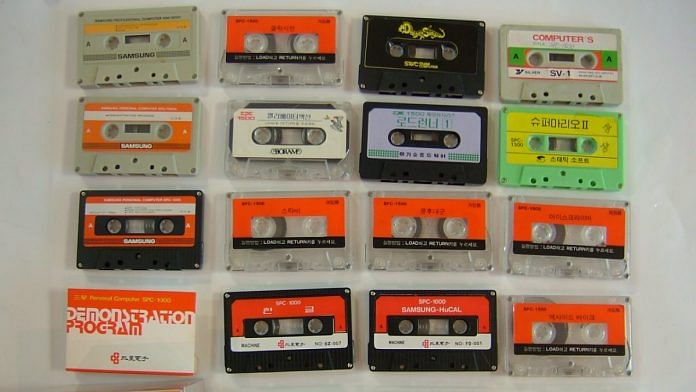One can explain the recent boom in vinyl record sales in terms that make sense to an audiophile; a vinyl record will often sound more nuanced than music in a compressed digital format. But the growing audio cassette sales don’t lend themselves to such technical explanations: They’re about culture and psychology rather than sound.
The hissing cassette was never music lovers’ first choice. The only reason these things were popular throughout my childhood and adolescence in the 1970s and ‘80s was their portability: You could play them on a boom box, in a car, on a Walkman when these appeared 40 years ago. The CD killed them off more ruthlessly than it did vinyl records: There was simply no reason to compromise so deeply on sound quality anymore.
And yet the cassette is back. In the U.K., sales were up 112% year on year in the first half of 2019, even if that means only 36,000 cassettes were sold. Sales in the U.S. are growing, too.
One even reads nice things about the way cassettes sound, like in this Medium post from Aubrey Norwood: “The sound tape gives is warm. Saturated. It promotes a degree of imperfection, and creates an underflow of infamous tape hiss that leaves the format feeling nakedly honest, which is gold dust for the sincere-inclined musician.”
Digital formats, of course, can replicate any imperfections an artist may desire – but that wouldn’t be sincere, would it?
If it were all about the sound, the cassette would have been as extinct as the wax cylinder (though, of course, plastic versions of those are still being made for people who can’t part with their phonographs). But our relationship with music is much more complicated than mere audio enjoyment. It can’t be described in terms of dynamic range. If it could be, popular streaming services wouldn’t have been able to sell us the compression-depleted recordings which we, to add insult to injury, often stream using Bluetooth.
In part, the cassette phenomenon is driven by the various mixtapes related to the Guardians of the Galaxy movie, in which a cassette tape plays an important, emotional part in the plot; they’ve stayed on bestseller lists for years. In a similar way, the movie Baby Driver, in which the protagonist listens to music on iPods, drove up the sales of the retro devices in 2017. (The movie was nominated for Academy Awards in sound mixing and sound editing.)
Many people perceive music through stories, both personal and invented, but always emotionally resonant. Sometimes the story is attached merely to a piece of music. Few people can remember what device played the song to which they first danced with their partner. Sometimes, though, the specific gadget or technology is important, too.
As Goran Bolin of the Sodertorn University in Stockholm wrote in 2014, people “develop specific, sometimes passionate, relationships with reproduction technologies such as the vinyl record, music cassette tape, comics, and other now dead or near-dead media forms.” The passion, as Bolin put it, “is activated by the nostalgic relationships with past media experiences, the bittersweet remembrances of media habits connected to one’s earlier life phases.” That means an attachment not just to a record, but to a specific record, which hiccups in a specific place and has a specific rip on its sleeve; not just to a song but to a cassette on which it was recorded as an afterthought.
Bolin did his research with older people – the World War II and Cold War generations. Many of the modern cassette or LP buyers never had any bittersweet childhood experiences with these media – but they’ve acquired a belated yearning for such experiences through some movie or another or the nostalgic memories of their parents’ generation. In other words, they want access to our experiences – a sense of emotional attachment to an object, something hard to achieve with a file in the cloud somewhere coming to the listener courtesy of a subscription service.
Nostalgia and emotional ownership are closely linked with physical frailty. I don’t recall deriving any pleasure from always having to roll chewed-up tape back into the cassette, but it’s important if you want an analog world experience with your music. “Cassettes are particularly potent because they signify death and decay more forcefully even than vinyl,” Joanna Demers from the University of Southern California wrote in 2017.
There’s also something about the tape revival that recalls the radicalism of the 1980s cassette culture: Tapes were cheap, and people used them to copy and share music from expensive records, an early form of piracy. In the Soviet Union when I grew up, the state record company wouldn’t put out the music we listened to – so bands and underground entrepreneurs distributed them on cassettes. “Today’s cassette culture, by eschewing contemporary media forms for more esoteric ones, is building on the older cassette culture tradition of rejecting dominant industry formats,” audio producer Craig Eley wrote in a 2011 essay.
All these motives probably contribute to the unlikely cassette sales bump; it seems old technology can never quite die if it is still capable of striking an emotional chord and carrying a story. Perhaps long after today’s digital assistants are history, some movie will revive interest in 2019 Alexas and Siris; asking one to play some Billie Eilish will be the cool, nostalgic, countercultural thing to do. -Bloomberg
Also read: Folk, hip-hop & country — regional music videos from Northeast are all the rage on YouTube




I own over 100 cassettes. Bought them through-out the 80s and 90s and the majority are type II Chrome with several type IV Metal. Strange to see how old technology becomes new.